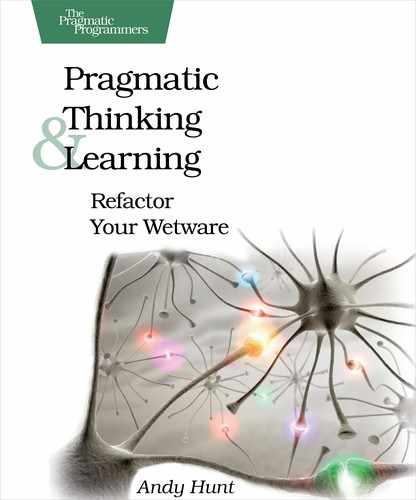How Do You Get There?
In this chapter, we’ve looked at features of your brain, including the L-mode and R-mode cognitive processes, and at rewiring your brain through practice. You should also begin to appreciate the underutilized power of R-mode.
So if this R-mode thing is so great—or at least so necessary at this particular point in time—what can you do to experience more R-mode processing yourself? What can you do to cultivate R-mode and better integrate L-mode and R-mode?
We’ll look at some specifics of how to achieve better cultivation and integration in the next chapter.
| Next Actions |
-
Make a short list of your favorite software applications and a list of the ones you just despise. How much does aesthetics play a role in your choices?
-
Consider what aspects of your work and home life target L-mode. What aspects of your work and home life target R-mode? Do you feel they are in balance? If not, what will you do differently?
-
Keep a doodle pad on your desk (and in your car, with your laptop, by your bed), and use it.
-
In addition, keep something on your person for 24×7 note taking (which may or may not be paper/pen based).
Try This
-
Make a conscious effort to learn something new primarily by synthesis, instead of analysis.
-
Try creating your next software design away from your keyboard and monitor (and we’ll talk more about this in detail a bit later in the book).
Footnotes
| [26] | |
| [27] |
Let’s hope you have just the one. |
| [28] |
See Hare Brain, Tortoise Mind: How Intelligence Increases When You Think Less [Cla00]. |
| [29] |
See Shufflebrain: The Quest for the Hologramic Mind [Pie81]. |
| [30] |
http://www.sciencemag.org/cgi/content/abstract/313/5790/1141 |
| [31] |
Verbal overshadowing of visual memories; some things are better left unsaid [SE90]. |
| [32] |
Technically, of course, there is no indexing going on, so it’s more like being at the end of a very long hash bucket with decreasing activation energy at each link. But metaphorically, just think of it as an index. |
| [33] |
Folks also recommend the Zebra T3 series; see http://www.jetpens.com for both a pen and mechanical pencil version. |
| [34] |
Remember to use your hands-free device per local laws :-). |
| [35] |
If you doubt this, just ask any venture capitalist. |
| [36] |
The cortex, which comes from the Latin word for tree bark, is the outer layer of folded gray matter and is key to conscious thinking. |
| [37] |
As described in The New Drawing on the Right Side of the Brain [Edw01] et al. |
| [38] |
They aren’t even measurable. HR can’t measure or reward most of these skills, at least not as easily as they can the L-mode traits. |
| [39] |
That was in 2006. The automotive business remains tough, however. |
| [40] |
Rumor has it that this parody was in fact created by a design group within Microsoft, possibly to complain about the constraints they were operating under. |
| [41] |
Emotional Design: Why We Love (or Hate) Everyday Things [Nor04]. |
| [42] | |
| [43] |
Aesthetics and Apparent Usability: Empirically Assessing Cultural and Methodological Issues [Tra97]. |
| [44] |
A Neuro-psychological Theory of Positive Affect and Its Influence on Cognition [AIT99]. |
| [45] | |
| [46] |
Thanks to June Kim for this one. |
| [47] | |
| [48] |
Described in The Brain That Changes Itself: Stories of Personal Triumph from the Frontiers of Brain Science [Doi07]. |
